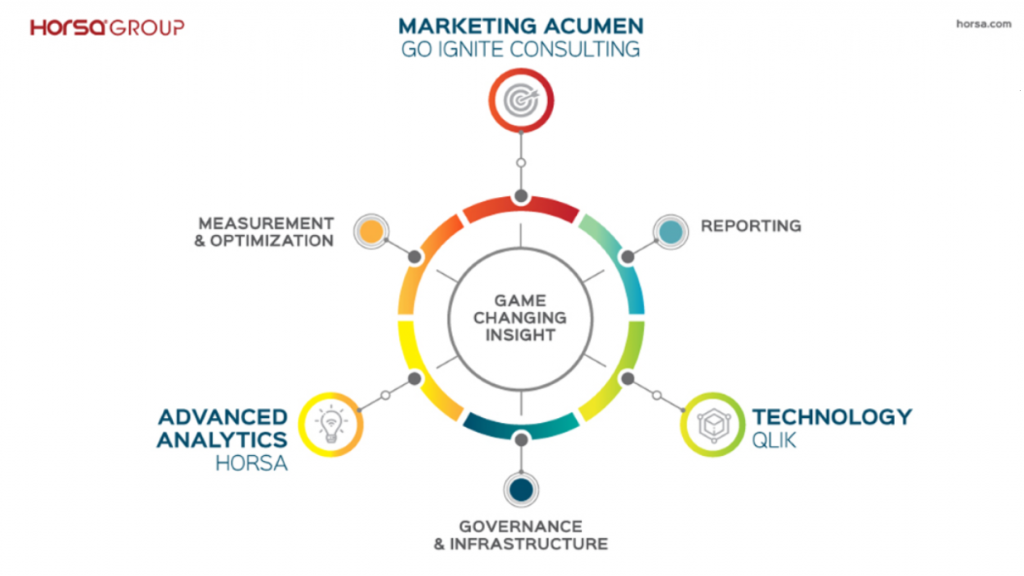
The role of customer management at many organisations continues to evolve. Gone are the days when a simple CRM system would do the trick. With increasing data and workloads, alongside increased expectations for ROI, it is about balancing the requirements of multiple stakeholders and departments.
Alongside this is the increasingly ludicrous martech landscape, which as of last year plotted more than 7000 vendors. Building out the right martech stack has never been more important for businesses to ‘deliver the sophisticated, personalised interactions that customers now expect‘, in the words of Tido Carriero, writing for this publication in July. As a result, it is becoming apparent that a single partner might not hit all the sweet spots.
With this in mind MarketingTech spoke with Nick Milne, founder of Go Ignite Consulting and an experienced marketing analyst, around the challenges marketers, data professionals and businesses face in this competitive landscape, as well as a new partnership which looks to unify customer management analytics.
MarketingTech: Hi Nick. Tell me about your career to date, the work Go Ignite Consulting does and the experience you’ve had in liaising with marketing managers and data professionals?
Nick Milne: I describe Go Ignite Consulting as a ‘Marketing Effectiveness’ accelerator; helping brands improve commercial return from marketing investment through improving their approach to Marketing Effectiveness. A successful approach to Marketing Effectiveness is based on a number of drivers:
- organisational culture
- data availability and frequency
- Marketing Effectiveness capabilities
- the role of those capabilities in aiding decision making and adoption into planning processes
- having a workforce with the right blend of skills (in house and agency partners)
- the right approach to combine data, evidence and creativity
This approach is based on my work primarily at O2 where I set up the marketing effectiveness function, and more recently at Samsung Europe where I built the customer and marketing analytics team and capabilities to service the 17 European local markets. I also have a background in using data within creative, media and data marketing agencies (VCCP, OMD and CACI).
Why I think I have been able to achieve this success is through acting as a conduit between data/insight functions and the rest of the organisation; marketing (brand and commercial), channel, operations, and finance. Being able to talk the language of other parts of the business and turn their challenges into data, analytics and insight opportunities is crucial to ensuring insight is believed and acted upon.
MT: Tell me from your experience about the data journey marketers have gone through in recent years – greater volume, greater insights – and how they have been coping?
NM: I have lost count of the number of times I have heard marketers talk about ‘analysis paralysis’ and I think this describes where a lot of organisations have ended up with the growth of data. More data is available than ever before, with greater frequency, and anyone within an organisation can get their hands on it which makes data governance and data literacy increasingly difficult.
This presents an environment where, without clear roles and accountabilities on who uses what data for what purpose, data can be used to post-rationalise decision making and you lose the power of impartiality that should be provided by data professionals.
MT: How does this impact to the data coming into an organisation – and are there any emerging challenges with how this is visualised, analysed, and actioned upon?
NM: There are three areas this impacts; data infrastructure, measurement and analytics.
It has become increasingly important for organisations to have a data infrastructure which can hold all types of data (structured and unstructured) and provide the flexibility to bring in and arrange new data in an instantly useable format. This then feeds the measurement/reporting and analytics.
With measurement it is important to provide a self-serve intelligence platform which clearly shows what is business critical to focus on. For example, splitting out strategic KPIs ( marketing investment, brand/product consideration, sales, market share) from operational KPIs (impressions, clicks, CTR, cost per click). But it is more than just the physical provision of the reporting; data professionals need to work with marketing to provide clear R&Rs; who decides what is measured, and who is responsible for explaining performance and act on the insight?
With analytics, gone are the times when you should have to wait for models to update. With continuous real-time analytics combined with automated predictive modelling organisations are given the opportunity to quickly identify new trends and opportunities to act upon.
All of this presents a really clear and strong opportunity and need for data professionals to be even closer to their marketing colleagues; to know their jobs, the decisions they have to make, and to turn their business challenges into data, reporting and analytics opportunities.
MT: How has this data journey impacted on martech and BI vendors’ strategies in your opinion?
NM: Given this change in accessibility to marketing (and other parts of organisations) it is no longer acceptable for vendors to simplify provide a solution. You need to become a trusted partner; understand the challenges faced by stakeholders and help become part of the solution. To do this credibly, it is best to have a subject matter expert who can spearhead the communications with an organisation.
If, as a technology vendor, your focus is the pre-sale and sale, then you need to partner with someone who can be your spokesman and advocate within the organisation. Otherwise there is increased risk of limited longevity of your platform within the organisation.
MT: How do you assess the rise of artificial intelligence (AI) and machine learning in this context? Is it a boon or has it been something of a misnomer for technical marketers?
NM: I believe AI and machine learning on their own are a bit of a misnomer and will give a couple of examples why.
Scenario 1: I have seen the terminology used by marketers to try to add more credibility to what they do, when they run the analytics themselves. You won’t suddenly become more effective by implementing AI or machine learning.
Scenario 2: Analysts increasing their analytics capabilities with the introduction of AI or machine learning without getting closer to the organisation and understanding the challenges and business questions these new capabilities should be helping answer.
In the right context and for the right reason AI and machine learning should accelerate the use of analytics into marketing decision making but, from a marketing perspective, I am yet to see this happen consistently well.
MT: You are to release a whitepaper with Horsa and Qlik on customer management analytics, formalising the concepts we have spoken about. What was the inspiration in putting this partnership together?
NM: Everything spoken about so far is exactly why Go Ignite Consulting and Horsa, powered by Qlik, have formed this partnership around the Customer Management Analytics proposition as we provide the perfect blend of marketing acumen, advanced analytics capabilities and technology as per the below visualisation:

I was responsible for bringing Horsa and Qlik into Samsung Europe and the partnership we created was a huge reason behind the success of SmartBI (Samsung Europe’s award-winning Business Intelligence platform, DataIQ 2019 Best Data Aggregation Initiative). So we know how to work together, how to bring the best of each other, and how to provide a service which is needed by and will be successful in organisations.
MT: What are you hoping readers will learn from the whitepaper and infographic?
NM: We are hoping that readers will identify with the challenges we have set out and have faith that there are people outside perhaps their usual ‘go to’ partners which could provide that missing ingredient.
What is on offer through the Customer Management Analytics may not be wildly different to models that are already up and running with organisations, but the flexibility, agility and power of the modelling approach combined with the marketing acumen which will set us apart from others.
MT: What advice would you give to any data professionals concerned about the changing marketing technology landscape, particularly amidst Covid-19?
For anyone concerned about how changing consumer behaviours in light of Covid-19 may impact (as detailed in the whitepaper) then I would say look at doing an objective assessment of your current set technology and analytics set up:
- Does your martech set up give you the flexibility to adapt?
- Do you have access to the relevant datasets which can help identify any changing consumer/customer behaviours?
- Do your models ‘learn’ or can be adapted at speed?
Editor’s note: You may qualify for a free readiness assessment by answering a few questions here: https://www.horsa.com/uk/en/customer-management-analytics.





